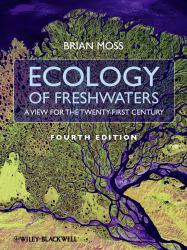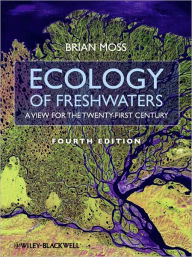
ISBN: 9781444334746
This new edition of an established textbook provides a comprehensive and stimulating introduction to rivers, lakes and wetlands, and was written as the basis for a complete course on fres… Mehr…
| BetterWorldBooks.com Versandkosten:zzgl. Versandkosten. Details... |

ISBN: 9781444334746
A digital copy of "Ecology of Fresh Waters" by Brian Moss. Download is immediately available upon purchase! 9781444334746,1444334743,ecology,fresh,waters,brian,moss Sciences > Ecology > G… Mehr…
| textbooks.com Download INSTANTLY! Format: VitalSource. Type: . Copying: Allowed, .2Â.182 selections may be copied daily for 2Â.1825 days. Printable: Allowed, .10Â.182 prints daily for 10Â.1825 days. Expires: No Expiration. Read Aloud?: Allowed. Sharing: Not Allowed. Software: Online: No additional software required Offline: VitalSource Bookshelf. Shipping to USA only! Agriculture & Animal Sciences > Agriculture > Ecology > General Ecology. Versandkosten: EUR 0.00 Details... |

ISBN: 9781444334746
4th Edition, by Brian R. Moss, PRINT ISBN: 9781444334746 E-TEXT ISBN: 9781444320411 Additional ISBNs: 1405113324, 9781405113328 Wiley Global Research (STMS) eBook Other pricing structure … Mehr…
| VitalSource.com new in stock United States. Versandkosten:plus shipping costs., zzgl. Versandkosten Details... |

ISBN: 9781444334746
Ecology of Fresh Waters: A View for the Twenty-First Century Ecology-of-Fresh-Waters~~Brian-Moss Nature & Wildlife>Environmental Issues>Environmental Issues Hardcover, Wiley
| BarnesandNoble.com new Versandkosten:zzgl. Versandkosten. Details... |

ISBN: 9781444334746
Fnac.com : Livraison gratuite et - 5% sur tous les livres. Ecology of Fresh Waters - Livre. Découvrez des nouveautés, des coups de cœur, des avis d'internautes, … Livre - Livre, Blackwell… Mehr…
| Fnac.com Nr. Versandkosten:, Le délai dépend du marchand, zzgl. Versandkosten. (EUR 8.30) Details... |


ISBN: 9781444334746
This new edition of an established textbook provides a comprehensive and stimulating introduction to rivers, lakes and wetlands, and was written as the basis for a complete course on fres… Mehr…

ISBN: 9781444334746
A digital copy of "Ecology of Fresh Waters" by Brian Moss. Download is immediately available upon purchase! 9781444334746,1444334743,ecology,fresh,waters,brian,moss Sciences > Ecology > G… Mehr…
ISBN: 9781444334746
4th Edition, by Brian R. Moss, PRINT ISBN: 9781444334746 E-TEXT ISBN: 9781444320411 Additional ISBNs: 1405113324, 9781405113328 Wiley Global Research (STMS) eBook Other pricing structure … Mehr…

ISBN: 9781444334746
Ecology of Fresh Waters: A View for the Twenty-First Century Ecology-of-Fresh-Waters~~Brian-Moss Nature & Wildlife>Environmental Issues>Environmental Issues Hardcover, Wiley
ISBN: 9781444334746
Fnac.com : Livraison gratuite et - 5% sur tous les livres. Ecology of Fresh Waters - Livre. Découvrez des nouveautés, des coups de cœur, des avis d'internautes, … Livre - Livre, Blackwell… Mehr…
Bibliographische Daten des bestpassenden Buches
| Autor: | |
| Titel: | |
| ISBN-Nummer: |
Detailangaben zum Buch - Ecology of Fresh Waters: A View for the Twenty-First Century
EAN (ISBN-13): 9781444334746
ISBN (ISBN-10): 1444334743
Gebundene Ausgabe
Erscheinungsjahr: 2010
Herausgeber: BLACKWELL PUBL
470 Seiten
Gewicht: 1,197 kg
Sprache: eng/Englisch
Buch in der Datenbank seit 2009-12-20T17:33:15+01:00 (Berlin)
Detailseite zuletzt geändert am 2023-06-22T00:41:30+02:00 (Berlin)
ISBN/EAN: 1444334743
ISBN - alternative Schreibweisen:
1-4443-3474-3, 978-1-4443-3474-6
Alternative Schreibweisen und verwandte Suchbegriffe:
Autor des Buches: moss
Titel des Buches: john waters, mosses, fresh, first water
Daten vom Verlag:
Autor/in: Brian R. Moss
Titel: Ecology of Fresh Waters - A View for the Twenty-First Century
Verlag: Wiley-Blackwell; John Wiley & Sons
480 Seiten
Erscheinungsjahr: 2010-04-13
Gewicht: 1,198 kg
Sprache: Englisch
155,00 € (DE)
Not available (reason unspecified)
196mm x 254mm x 27mm
BB; Hardcover, Softcover / Biologie/Ökologie; Ökologie, Biosphäre; Biowissenschaften; Freshwater Ecology; Life Sciences; Ökologie; Ökologie / Süßwasser; Süsswasserökologie; Ökologie / Süßwasser; BC
Preface. 1. Introduction. 1.1 Why? Further reading. 2. Water, a remarkable unremarkable substance. 2.1 Introduction. 2.2 The molecular properties of water and their physical consequences. 2.3 How much water is there and where is it? 2.4 Patterns in hydrology. 2.5 Bodies of water and their temperatures. 2.5.1 Lakes and latitude. 2.6 Viscosity of water, fluid dynamics and the diffusion of gases. 2.6.1 Diffusion. Further reading. 3. Why the chemistry of water is so important. 3.1 Introduction. 3.1.1 Polar and covalent compounds. 3.2 The atmosphere. 3.3 Major ions. 3.4 Global patterns in major ions: glaciation and endorheism. 3.5 Open and closed basins. 3.6 The big picture. Further reading. 4. More water chemistry: the key nutrients, trace elements and organic matter. 4.1 Introduction. 4.2 Concepts of limiting substances. 4.3 Nutrients. 4.4 Phosphorus. 4.5 Nitrogen. 4.6 Pristine concentrations. 4.7 Trace elements and silicon. 4.8 Organic substances. 4.8.1 Patterns in DOM availability. 4.9 Substance budgets. 4.10 Sediment-water relationships. Further reading. 5. Light thrown upon the waters. 5.1 Light. 5.2 From above to under the water. 5.3 From physics and chemistry to biology. Further reading. 6. Evolution and diversity of freshwater organisms. 6.1 Introduction. 6.2 The ecological theatre and the evolutionary play. 6.3 The freshwater biota. 6.4 Living in freshwaters. 6.5 Dispersal among freshwaters. 6.6 Patterns in freshwater diversity. 6.7 The fish of Lake Victoria. 6.8 Low diversity freshwater habitats. 6.9 A summary of the freshwater biota and its problems. Further reading. 7. Headwater streams and rivers. 7.1 Introduction. 7.2 General models of stream ecosystems. 7.3 A basic lesson in stream flow. 7.4 Flow and discharge. 7.5 Laminar and turbulent flow. 7.6 Particles carried. 7.7 The response of stream organisms to shear stress. 7.8 Community composition in streams. 7.8.1 Algal and plant communities. 7.8.2 Macroinvertebrates. 7.9 Streams in cold climates: the polar and alpine zones. 7.10 Stream systems in the cold temperate zone. 7.11 Warm temperate streams. 7.12 Desert streams. 7.13 Tropical streams. Further reading. 8. Uses, misuses and restoration of headwater streams and rivers. 8.1 Traditional use of headwater river systems. 8.2 Deforestation. 8.3 Acidification. 8.4 Eutrophication. 8.5 Commercial afforestation. 8.6 Settlement. 8.7 Engineering impacts. 8.8 Alterations of the fish community by man. 8.9 Sewage, toxic pollution and their treatment. 8.10 Diffuse pollution. 8.11 River monitoring. 8.12 The Water Framework Directive. 8.13 Implementation of the Directive. 8.14 Wider considerations: ecosystem services. 8.15 Restoration, rehabilitation and reconciliation ecology. 8.16 Reconciliation ecology of river systems. Further reading. 9. Middle stage and depositional floodplain rivers. 9.1 Introduction. 9.2 Change from an erosive river to a depositional one. 9.3 Submerged plants. 9.4 Growth of submerged plants. 9.5 Methods of measuring the primary productivity of submerged plants. 9.6 Submerged plants and the river ecosystem. 9.7 Further downstream - swamps and floodplains. 9.8 Swamp and marsh animals. 9.8.1 Whitefish and blackfish. 9.9 Latitudinal differences in floodplains. Further reading. 10. Floodplain ecosystems and human affairs. 10.1 Introduction. 10.2 Floodplain services. 10.2.1 Floodplain fisheries. 10.3 Floodplain swamps and human diseases. 10.4 Case studies. 10.5 River and floodplain management and rehabilitation. 10.6 Interbasin transfers and water needs. Further reading. 11. Lakes and other standing waters. 11.1 Introduction. 11.2 The origins of lake basins. 11.3 Lake structure. 11.4 The importance of the catchment area. 11.5 Lakes as autotrophic or heterotrophic systems. 11.6 The continuum of lakes. 11.7 Lake history. 11.10 Filling in. 11.11 Summing up. Further reading. 12. The communities of shallow standing waters: mires, shallow lakes and the littoral zone. 12.1 Introduction. 12.2 The scope of mires and littoral zones. 12.3 The structure of littoral communities. 12.4 Heterotrophs among the plants. 12.4.1 Neuston. 12.5 Linkages, risks and insurances among the littoral communities. 12.6 Latitude and littorals. 12.7 The role of the nekton. 12.8 Further reading. 13. Plankton communities of the pelagic zone. 13.1 Kitchens and toilets. 13.2 Phytoplankton. 13.3 Heterotrophs in the plankton: viruses and bacteria. 13.4 Protozoa and fungi. 13.5 Zooplankton. 13.6 Fish in the open-water community. 13.7 Piscivores and piscivory. 13.8 Functioning of the open-water community. Further reading. 14. The profundal zone. 14.1 The end of the line. 14.2 The importance of oxygen. 14.3 Profundal communities. 14.4 Biology of selected benthic invertebrates. 14.5 What the sediment-living detritivores really eat. 14.6 Influence of the open water community on the profundal benthos. Further reading. 15. The uses, abuses and restoration of standing waters. 15.1 Introduction. 15.2 Services provided by standing waters. 15.3 Fisheries. 15.4 Changes in fisheries: two case studies. 15.5 Fish culture. 15.6 Stillwater angling. 15.7 Amenity culture and the aquarium trade. 15.8 Domestic water supply, eutrophication and reservoirs. 15.8.1 Eutrophication - human induced changes in the production of lakes. 15.8.2 Dams and reservoirs. 15.8.3 Fisheries in new lakes. 15.8.4 Effects downstream of the new lake. 15.8.5 New tropical lakes and human populations. 15.8.6 Man-made tropical lakes, the balance of pros and cons. 15.9 Amenity and conservation. 15.10 Restoration approaches for standing waters: symptom treatment. 15.11 Treatment of proximate causes: nutrient control. 15.12 Habitat creation. Further reading. 16. Climate change and the future of freshwaters. 16.1 The Merchant of Venice. 16.2 Climate change. 16.3 Existing effects of freshwaters. 16.4 Future effects. 16.5 Control and mitigation of global warming. 16.6 The remedy of ultimate causes. Further reading. 17. Problem exercises. 1. Stratification. 2. Catchments and water chemistry. 3. The Vollenweider model. 4. Nutrient budgeting. 5. Light penetration. 6. Biodiversity. 7. Problems with a frog. 8. Predation in streams. 9. Deforestation and tropical streams. 10. Swamp habitats and insect adaptations. 11. Ecosystem valuation in a floodplain. 12. Top down and bottom up control in shallow and deep lakes. 13. Palatability of aquatic plants to fish. 14. The plankton of paddling pools. 15. Probing the profundal. 16. The curse of birds for lake managers. 17. Nutrient problems in tricky situations. References. Index.Weitere, andere Bücher, die diesem Buch sehr ähnlich sein könnten:
Neuestes ähnliches Buch:
2901405113327 Ecology of Fresh Waters: A View for the Twenty-First Century (Brian R. Moss)
- 2901405113327 Ecology of Fresh Waters: A View for the Twenty-First Century (Brian R. Moss)
- 9781118687796 Ecology of Fresh Waters (Brian R. Moss)
- 9780632004034 Ecology of Fresh Waters, (MOSS,)
- 9780470269428 Ecology of Fresh Waters (Moss, Brian)
- Ecology of Fresh Waters: A View for the Twenty-First Century
< zum Archiv...

